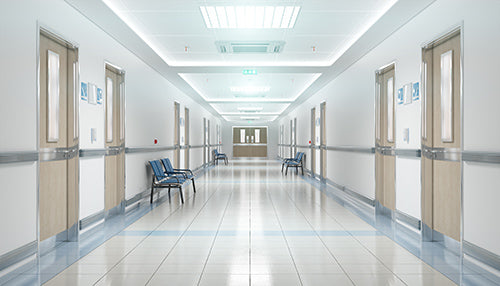The management of facilities is an ever-evolving discipline, requiring a keen awareness of innovation, efficiency, and sustainability. Given the evolving public health environment, facilities managers are now tasked with ensuring high levels of indoor air quality (IAQ) and minimizing risks associated with surface-transmitted pathogens.
In this study, we compare two different methodologies of facility disinfection, with specific focus on restrooms, break rooms, elevators, offices, conference rooms, lobbies, patient rooms, and fitness centers. The aim is to evaluate these approaches and provide recommendations to facilities managers looking to enhance their disinfection regimes.

Methodology 1: Manual Wipe
Disinfection is performed by manually wiping high touch points, with hard surfaces treated ranging from an estimated 5% to 25% depending on the area. Most disinfection technicians work on a 4-hour shift giving them an average of 203 minutes (3-1/3 hours) to complete their tasks. An important note in this traditional methodology is that air quality is not addressed.
Disinfectants typically used by the technicians have a dwell time of 10 minutes and are manually applied using a combination of paper towels and pre-wet wipes for restroom areas or cotton rags for other areas. If using a wet wipe, the user instructions indicate to “continue wiping for the duration of the dwell that is necessary”.
As a result, this manual wiping method using traditional disinfectants also has an adverse impact to the user and occupants due to exposure of increased Volatile Organic Compounds (VOC’s). Resulting in an increased contaminant exposure to occupants due to poor IAQ within the space that is suspended for hours.
Methodology 2: Electrostatic Sprayer
Disinfection is performed using an Air-Atomizing Induction Charging (AAIC) electrostatic spray system* in conjunction with an HOCl disinfectant with a 1-minute dwell time**. This approach treated 100% of the air particulates and all hard surfaces, with a >70% reduction in labor time, down to approximately 55 minutes. This technology promoted safety for end-users and was a more efficient process.
This approach had a significant positive impact on IAQ and VOCs as demonstrated by the air monitoring system displaying particulate counts, VOC, and CO2.
Conclusion:
The benefits of AAIC electrostatic spray system outweighed manual method with positive impact on air and a drastic increase in surface treatment, a significant reduction in completion time, and vastly improved IAQ. Adopting this new methodology aligns with the evolving needs of facilities management during the current public health context.
*ByoPlanet JetPack and Jet H2 Ultra
** Clean Republic Multi-Purpose Disinfectant
